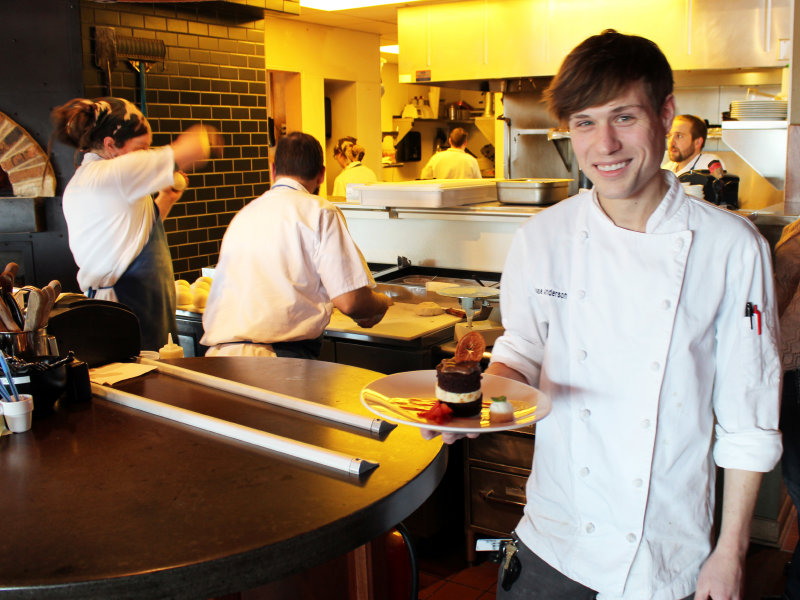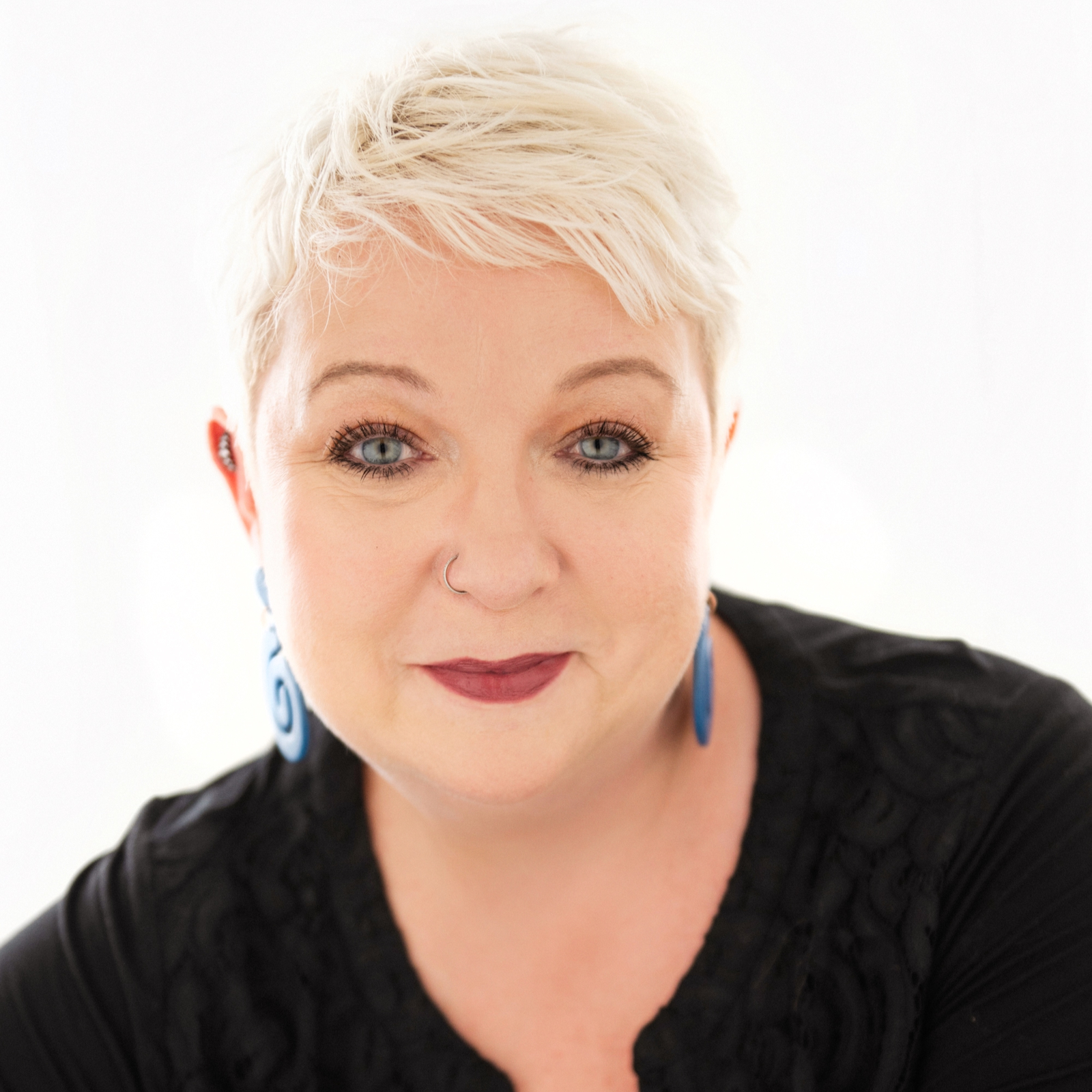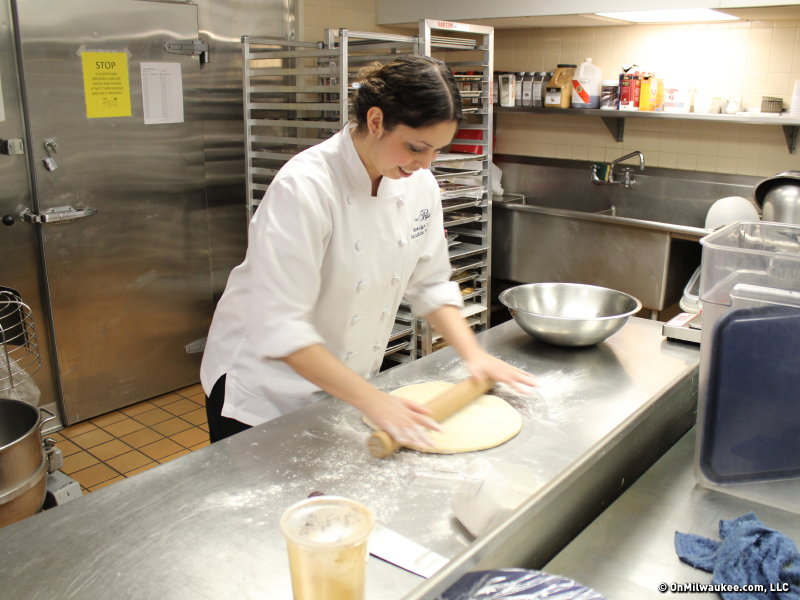You may never have met Wolf Peach’s Pastry Chef Chase Anderson, but if you’re like countless other folks who’ve passed through the doors of the restaurant, you’ve probably sampled his "to die for" chocolate polenta cake, served with preserved strawberries, caramel, and a scoop of Purple Door’s salted caramel ice cream.
The dessert has quickly become Anderson’s claim to fame, outselling even the restaurant’s popular Margherita pizza.
Despite his talent, Anderson is as unassuming as they come. Largely working behind the scenes, Anderson approaches his craft deliberately, with a thoughtfulness that belies a breadth of experience far beyond his 25 years.
A native of Kansas City, Kan., Anderson moved to Green Bay, where he took a job at age 14 working garde manger at Hinterland with Chef Dan Van Rite. After a few years in the kitchen, Anderson moved to New York to study at the Culinary Institute of America in Hyde Park.
After graduation, he worked at restaurants in Nashville and Knoxville, before moving to Mexico, where he stayed for nine months. There, he began learning to make Mexican desserts, as well as learning the basics of bread production.
Ultimately, Anderson returned to Van Rite’s kitchen, assisting him with the opening of Hinterland Erie Street Gastropub in Milwaukee. He eventually moved over to Roots, where he worked under the tutelage of Executive Chef Paul Zerkel, and most recently, Dan Jacobs, with whom he weathered the transition of the restaurant from Roots to Wolf Peach.
I sat down with Anderson on a crisp Friday afternoon, and we had a great chat about his work at Wolf Peach, his impressions of the pastry scene in Milwaukee, and his creative process.
OnMilwaukee.com: What tasks do you handle at Wolf Peach?
Chase Anderson: We have a full pastry kitchen, so we do all of our desserts and some of our ice creams, with the exception of what we get from Purple Door. We also do sourdough, focaccia, French bread, ciabatta, English muffins, bagels, brioche and cinnamon rolls. So, everything we use bread-wise is done here. The only thing we don’t make in house are the gluten free breads and pizza dough.
OMC: How did you develop affection for pastry?
CA: For some reason desserts really came naturally to me. I’m not a dessert person, but I love sweets, candy, anything with sugar. Plating always came easily.
Chocolate cake, tarts … those are easy. I think in subtleties. So, for instance, when I make a chocolate cake, it’s natural for me to boost the flavor with coffee or vanilla.
OMC: What about bread?
CA: Bread is more difficult. You have only four ingredients, and you have to make flavor with very little. So, you have to coax flavors out of it.
At Roots I was famous for doing ten things at once, but here I don’t have that luxury. Bread is so hands-on. You always have to be paying attention. It’s not exactly in my comfort zone.
OMC: How do you go about the process of brainstorming new ideas for the menu?
CA: I’m always writing things. Now that this is my career, it’s a constant process. But, when I’m deliberately writing a menu, I start with a template and a list of products. Then I let life inspire me.
Dessert writing should be kind of free. It’s about experience. Say you’re going to El Rey. You see a restaurant that says "tostadas and chiles" … and you think, maybe that could work for a dessert. I used to keep a notebook by my bed for when I’d think of ideas in the middle of the night.
Unlike many chefs, I actually write recipes. So, if I want to do a chocolate cake, I actually formulate that cake. I don’t just print off a recipe from online and use it. I can’t tell you how many experimental cakes my partner has eaten.
OMC: There’s been resurgence in the world of pastry and breads in Milwaukee. What do you see coming back?
CA: I read a lot of trend magazines. A lot of nostalgic things are coming back, like the trifle. Simple flavors: oranges and cream, pecans with chocolate and caramel.
Simple things are awesome. I mean, I can put a foam on this, or use liquid nitrogen, but I don’t really understand the dish until I understand the ingredients, the subtle nuances of flavor. For instance, when you taste honey, there’s so many different flavors you get – the flowers, caramel, nuttiness. And you have to completely understand those to write an amazing dish. I think customers are beginning to understand that.
Unfortunately, we live in Wisconsin, so we don’t have the most options in winter. But, I’m looking forward to grilled fruits and maple syrup in the summertime. Roots was a farm to table restaurant, and we’ve carried that over here. People really love the unadulterated fruit.
There’s a saying in music that a virtuoso isn’t made until they understand silence. Musicians can play and play and play, but you can’t master music until you understand pauses and silence.
OMC: What’s your impression of the pastry "scene" in Milwaukee?
CA: I think it’s amazing. I was kind of caught off guard when I found out about this series. It’s really great. Pastry chefs are unsung heroes. I know people really support Milwaukee chefs, but they need to support the pastry chefs too. We’re like the stage crew. And our chefs are the rock stars.
We also have great bakeries. Rocket Baby – their brioche melts in your mouth like butter. It’s kind of not fair; they’re such virtuoso bakers.
I always hear my college-aged friends say that they can’t wait to get out of Milwaukee. It makes me want to scream. I’ve lived a lot of places, but I really love it here.
OMC: What classic techniques are you working to master?
CA: I would love to improve my baking skills. When I taught myself to bake, I didn’t have anyone to show me proper techniques. I learned from books and pictures. But, I’m chasing for the perfect tasting, textured French bread. It gets closer and closer every day.
OMC: Which ones drive you nuts?
CA: Laminated dough. I love biscuits and pie dough, but we made our own puff pastry here for the first month and I just hated it. It was awful.
Our pastry area is really hot, so I’d sit down with the dough and the butter. I’d start layering them and it would get too hot, so I’d have to drag everything upstairs. It’s a beautiful thing – but so much work, and you need the right environment.
OMC: Where would you place yourself on the continuum of classic to innovative? Why?
CA: I’d say I’m probably more classic, traditional. I do like to experiment and do crazy things. But, it always goes back to the techniques I was trained to use. I’m much more traditional in my approach, but I like to experiment with flavors.
I like to be avant-garde and think outside the box. One of my first baked mousse recipes was an avocado mousse with grapefruit accompaniments. I was the only one who really thought it was great.
OMC: Who are your biggest influences?
CA: My biggest culinary influence is Dan Van Rite. He shaped me the most. He taught me to work hard, not to take work too seriously. My father has been a huge influence on my work ethic and my ability to keep going and going. Currently, my mentor is Andrew Ruiz; he’s a great guy. He’s passionate, and his dishes are solid.
OMC: What are your favorite flavors to work with?
CA: When I wrote the current menu, I was really big on orange and orange zest. It’s in everything.
I actually don’t like chocolate. I’m a vanilla guy. The way I try to explain it – vanilla seems simple and plain, but when you really taste it, it’s incredibly complex. It’s flowery, nuanced. I think chocolate is plain. There’s just one note, and that’s chocolate.
OMC: Do you think there are flavors/techniques/desserts that are overused?
CA: There probably are things that are overused. But, so what? I’d be the worst critic ever… I just want people to do their own thing and make beautiful food.
Chocolate is overdone on my menu. But, that’s what sells. Put chocolate on anything and it sells.
But, overall, I don’t think things are overdone. Making things from scratch and putting them on a menu is important. It’s great because you’re making it with your own hands. It’s not coming from Sysco in a box that says "almond cake" on it. To be a chef and to be a successful restaurant, you need to understand each step in making the final product.
I think it’s important to take things that are done in restaurants a lot – like crème brulee and molten chocolate cake -- and make them your own. I added polenta to our molten chocolate cake to set it apart.
OMC: What are some dishes you’d love to make, if given the opportunity?
CA: I’d really love to have a bread basket. I’d love to do the pan de bollo I discovered in Mexico, a sweet dough stuffed with cream cheese. You’ll find them all over there – people keeping them in baskets, and customers picking them up to eat on the way to work.
I also really love the idea of putting chiles in desserts, but I haven’t really come up with anything that fits the restaurant yet.
As a passionate champion of the local dining scene, Lori has reimagined the restaurant critic's role into that of a trusted dining concierge, guiding food lovers to delightful culinary discoveries and memorable experiences.
Lori is an avid cook whose accrual of condiments and spices is rivaled only by her cookbook collection. Her passion for the culinary industry was birthed while balancing A&W root beer mugs as a teenage carhop, fed by insatiable curiosity and fueled by the people whose stories entwine with every dish. Lori is the author of two books: the "Wisconsin Field to Fork" cookbook and "Milwaukee Food". Her work has garnered journalism awards from entities including the Milwaukee Press Club. In 2024, Lori was honored with a "Top 20 Women in Hospitality to Watch" award by the Wisconsin Restaurant Association.
When she’s not eating, photographing food, writing or planning for TV and radio spots, you’ll find Lori seeking out adventures with her husband Paul, traveling, cooking, reading, learning, snuggling with her cats and looking for ways to make a difference.





